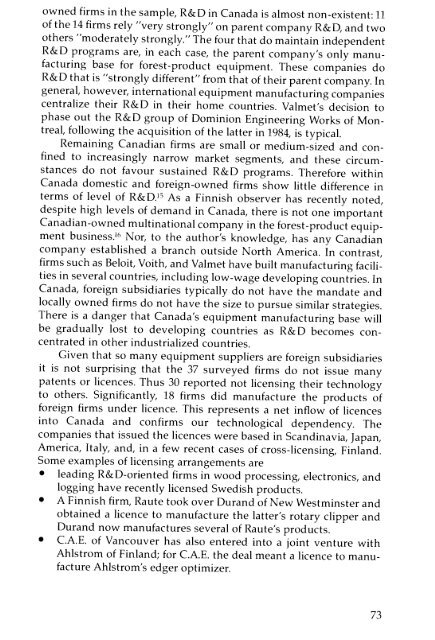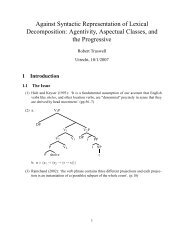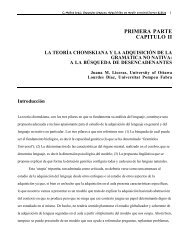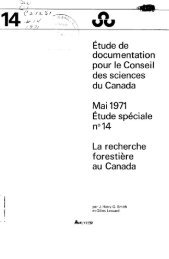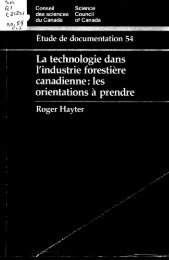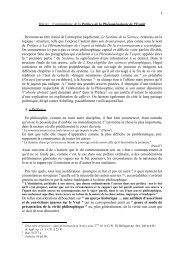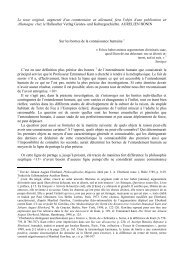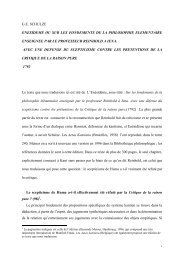forest-product equipment patents, which are conventionally regardedas a useful indicator of R&D output.' According to Hanel, patentcounts between 1978 <strong>and</strong> 1980 reveal <strong>Canadian</strong> inventors to be mostcompetitive in forestry machinery but progressively less so withrespect to wood processing, pulp <strong>and</strong> paper, <strong>and</strong> paper-convertingtechnology." Canada accounted for 28.9 per cent of <strong>the</strong> 135 patentsissued between 1978 <strong>and</strong> 1980 with respect to forestry equipment, forexample, but only 8.9 per cent of <strong>the</strong> 395 pulp <strong>and</strong> paper patents <strong>and</strong>5.8 per cent of <strong>the</strong> 208 paper-converting patents during <strong>the</strong> sameperiod. The same relative differences, only less marked, appear in a 10per cent sample of patents issued between 1950 <strong>and</strong> 1975. 11 Hanel goeson to note that Canada's traditional strengths in forestry equipmentare being reduced by stiff Swedish competition, <strong>and</strong> (recent) pulp <strong>and</strong>paper machinery patents are overwhelmingly concentrated in <strong>the</strong>h<strong>and</strong>s of American, Swedish, <strong>and</strong> Finnish firms.!?Most R&D efforts in Canada by equipment suppliers for <strong>the</strong> forestproductindustries are in logging <strong>and</strong> wood processing. The high levelof dem<strong>and</strong> for technology in <strong>the</strong>se industries, <strong>the</strong> high proportion ofentrepreneurs, <strong>and</strong> <strong>the</strong> distinctive nature of <strong>the</strong> <strong>Canadian</strong> forestenvironment contribute toward <strong>Canadian</strong> excellence. Even here, however,foreign firms are making inroads. In particular, in <strong>Canadian</strong>woods <strong>and</strong> wood-processing operations, indigenous technology israpidly being supplanted by innovations from Austria, Finl<strong>and</strong>, Germany,Italy, Switzerl<strong>and</strong>, Sweden, <strong>and</strong> Japan, as well as <strong>the</strong> UnitedStates. Stellite tip manufacturing equipment <strong>and</strong> Detenso blades aretwo examples (see chapter 3). Ano<strong>the</strong>r is <strong>the</strong> "spider-like" machinesdeveloped in Switzerl<strong>and</strong> <strong>and</strong> Austria for silvicultural site preparationin extremely steep terrain.!' Italian manufacturers also recentlystarted to assess <strong>the</strong> <strong>Canadian</strong> market for a variety of wood-processingmachinery.'!With respect to highly processed products - pulping equipment,paper machinery, <strong>and</strong> electronic equipment for <strong>the</strong> forest industry <strong>Canadian</strong> technological capabilities are weak. Among surveyed firmsonly two, both <strong>Canadian</strong>-owned, are reasonably strong R&D performersin <strong>the</strong>se fields. These products can be st<strong>and</strong>ardized in amanner that facilitates global sales. Even if <strong>the</strong> efforts of two companiesnot included in <strong>the</strong> sample are recognized, <strong>Canadian</strong> in-houseR&D levels in <strong>the</strong> technologically most dynamic aspects of forestproductmanufacturing are limited.Despite <strong>the</strong> activities of <strong>the</strong> Foreign Investment Review Agency(FlRA), foreign firms have been permitted to acquire <strong>Canadian</strong> forestproductsuppliers with little restriction. And high levels of foreignownership mean less <strong>Canadian</strong>-based R&D. In 14 of <strong>the</strong> 18 foreign72
owned firms in <strong>the</strong> sample, R&D in Canada is almost non-existent: 11of <strong>the</strong> 14 firms rely "very strongly" on parent company R&D, <strong>and</strong> twoo<strong>the</strong>rs "moderately strongly." The four that do maintain independentR&D programs are, in each case, <strong>the</strong> parent company's only manufacturingbase for forest-product equipment. These companies doR&D that is "strongly different" from that of <strong>the</strong>ir parent company. Ingeneral, however, international equipment manufacturing companiescentralize <strong>the</strong>ir R&D in <strong>the</strong>ir home countries. Valmet's decision tophase out <strong>the</strong> R&D group of Dominion Engineering Works of Montreal,following <strong>the</strong> acquisition of <strong>the</strong> latter in 1984, is typical.Remaining <strong>Canadian</strong> firms are small or medium-sized <strong>and</strong> confinedto increasingly narrow market segments, <strong>and</strong> <strong>the</strong>se circumstancesdo not favour sustained R&D programs. Therefore withinCanada domestic <strong>and</strong> foreign-owned firms show little difference interms of level of R&D.IS As a Finnish observer has recently noted,despite high levels of dem<strong>and</strong> in Canada, <strong>the</strong>re is not one important<strong>Canadian</strong>-owned multinational company in <strong>the</strong> forest-product equipmentbusiness." Nor, to <strong>the</strong> author's knowledge, has any <strong>Canadian</strong>company established a branch outside North America. In contrast,firms such as Beloit, Voith, <strong>and</strong> Valmet have built manufacturing facilitiesin several countries, including low-wage developing countries. InCanada, foreign subsidiaries typically do not have <strong>the</strong> m<strong>and</strong>ate <strong>and</strong>locally owned firms do not have <strong>the</strong> size to pursue similar strategies.There is a danger that Canada's equipment manufacturing base willbe gradually lost to developing countries as R& D becomes concentratedin o<strong>the</strong>r industrialized countries.Given that so many equipment suppliers are foreign subsidiariesit is not surprising that <strong>the</strong> 37 surveyed firms do not issue manypatents or licences. Thus 30 reported not licensing <strong>the</strong>ir technologyto o<strong>the</strong>rs. Significantly, 18 firms did manufacture <strong>the</strong> products offoreign firms under licence. This represents a net inflow of licencesinto Canada <strong>and</strong> confirms our technological dependency. Thecompanies that issued <strong>the</strong> licences were based in Sc<strong>and</strong>inavia, Japan,America, Italy, <strong>and</strong>, in a few recent cases of cross-licensing, Finl<strong>and</strong>.Some examples of licensing arrangements are• leading R&D-oriented firms in wood processing, electronics, <strong>and</strong>logging have recently licensed Swedish products.• A Finnish firm, Raute took over Dur<strong>and</strong> of New Westminster <strong>and</strong>obtained a licence to manufacture <strong>the</strong> latter's rotary clipper <strong>and</strong>Dur<strong>and</strong> now manufactures several of Raute's products.• C.A.E. of Vancouver has also entered into a joint venture withAhlstrom of Finl<strong>and</strong>; for C.A.E. <strong>the</strong> deal meant a licence to manufactureAhlstrom's edger optimizer.73
- Page 3 and 4:
Science Council of Canada100 Metcal
- Page 5 and 6:
ContentsForewordAcknowledgments1113
- Page 7 and 8:
In-House R&D by Equipment Suppliers
- Page 9 and 10:
Table 2.5: R&D Employment in 10 Can
- Page 11 and 12:
ForewordTechnological innovation an
- Page 14 and 15:
adapted sufficiently rapidly to the
- Page 16 and 17:
Finally, the author interviewed sen
- Page 18 and 19:
Table 1.3: Degree of Foreign Contro
- Page 20 and 21: Figure 1.1: Innovation Patterns and
- Page 22 and 23: Since 1945 the pace of technologica
- Page 24 and 25: Toward Reliance on Research rather
- Page 26 and 27: science occurred between 1900 and 1
- Page 28 and 29: Forestry Sector R&D SystemIn Canada
- Page 30 and 31: up its forestry research group at N
- Page 32 and 33: and one other that was strongly ori
- Page 34 and 35: closely involved in the establishme
- Page 36 and 37: to vet and control research priorit
- Page 38 and 39: In-House R&D by Equipment Suppliers
- Page 40 and 41: product. One, by no means atypical,
- Page 42 and 43: only internal source of dissolving
- Page 44 and 45: of which only 18 per cent came from
- Page 46 and 47: New information can be generated by
- Page 48 and 49: Chapter 3The R&D System andHow It W
- Page 50 and 51: Table 3.2: Summary Characteristics
- Page 52 and 53: Sixteen firms provided details on s
- Page 54 and 55: The Opco Process: A Case Study of I
- Page 56 and 57: however, within the last two decade
- Page 58 and 59: in 1959, and a full-scale experimen
- Page 60 and 61: Papritection was developed as follo
- Page 62 and 63: Further tests were conducted in 198
- Page 64 and 65: fully automatic machines, and its s
- Page 66 and 67: Chapter 4Technological Capability a
- Page 68 and 69: Table 4.2 provides measurements of
- Page 72 and 73: Foreign-Ownership and In-House R&DT
- Page 74 and 75: Technological Liaisons: Forest-Prod
- Page 76 and 77: for this deficiency the federal gov
- Page 78 and 79: On the other hand, three of the lea
- Page 80 and 81: one of Sweden's forest-products gia
- Page 82 and 83: Capital Investments in the Canadian
- Page 84 and 85: and Quebec accounted for 33.9 per c
- Page 86 and 87: Table 5.5: Canadian Forest-Product
- Page 88 and 89: Scandinavian manufacturers are in t
- Page 90 and 91: was implemented smoothly and manage
- Page 92 and 93: the foundations were poured, until
- Page 94 and 95: inherent capabilities were never fu
- Page 96 and 97: especially in the east, has receive
- Page 98 and 99: "export staples mentality." The bel
- Page 100 and 101: size of the conglomerates would cer
- Page 102 and 103: the concept of flexibility explicit
- Page 104 and 105: This author therefore recommends th
- Page 106 and 107: with respect to technology transfer
- Page 108 and 109: of the R&D system and influence the
- Page 110 and 111: operations, attitudes toward innova
- Page 112 and 113: limited R&D base, but they do empha
- Page 114 and 115: The small size and non-innovative n
- Page 116 and 117: Promoting In-House R&D in the Fores
- Page 118 and 119: Notes1. The Technological Challenge
- Page 120 and 121:
7. For example, nj. Daly, "Weak Lin
- Page 122 and 123:
7. P.G. Mellgren and E. Heidersdorf
- Page 124 and 125:
this R&D facility has become even s
- Page 126 and 127:
3. K. Noble, "Forest Industry Urged
- Page 128 and 129:
Publications of the ScienceCouncil
- Page 130 and 131:
Reports on Matters Referred by the
- Page 132 and 133:
No. 40. Government Regulation of th
- Page 134 and 135:
1981An Engineer's View of Science E


